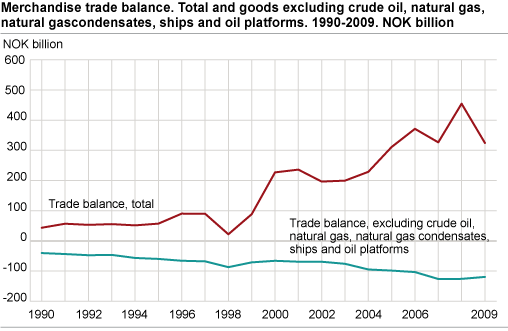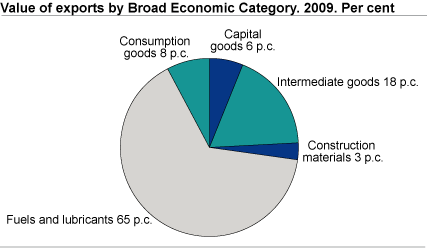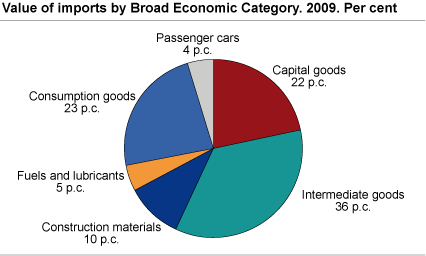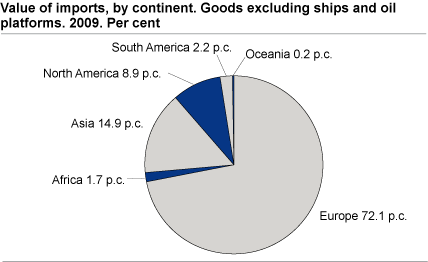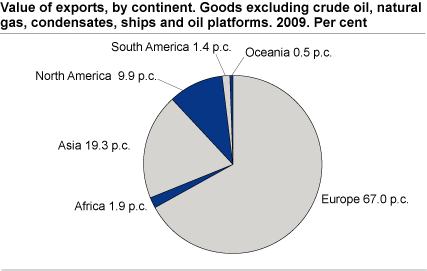Content
Published:
This is an archived release.
Trade balance down in 2009
The Norwegian external trade in 2009 was influenced by the global economic situation. A decline in all foreign trade, for imports as well as exports, resulted in a trade surplus of NOK 130.1 billion lower than the record year of 2008. The decline was mainly due to low export prices of crude oil and natural gas.
The trade surplus in 2009 came to NOK 324.4 billion, down from NOK 454.5 billion in 2008. Not since 2005 has the surplus been this low. The total export value of commodities reached NOK 756.8 billion, while imports ended at NOK 432.4 billion. Both the value for exports and for imports showed a decline compared with 2008. In 2009, exports accounted for 32 per cent of the gross national product, while imports accounted for 18 per cent.
The decrease in exports of more than 21 per cent from 2008 was mainly due to less oil and gas revenues. By excluding these shelf commodities, the exports declined by 14.7 per cent.
The global financial situation in 2009 also influenced the national market. Imports were reduced by 14.3 per cent in contrast to an increase of 7.1 per cent in 2008 and 13.9 per cent in 2007. Most of the main commodity groups declined compared to 2008. As an example, imports of road vehicles alone fell by almost NOK 10 billion.
Low crude oil price
Last year the Norwegian export value of crude oil amounted to NOK 243.5 billion, a decline of NOK 115.9 billion from 2008. The average crude oil price fell from NOK 539 in 2008 to NOK 379 per barrel last year. In 2009, we exported 642.3 million barrels of crude oil, a decline of NOK 24.2 million, or 3.6 per cent compared to the previous year.
Natural gas - increased exports volume
The export value of Norwegian natural gas came to NOK 191.7 billion in 2009, down from NOK 219.5 billion in 2008. The value includes natural gas, both in liquid and gaseous state, the latter being the most important. The exported volume of natural gas increased by 2 billion Sm3 (standard cubic metres), or 2.1 per cent. Total exported volume reached 96.6 billion Sm3 and a value of NOK 186.9 billion in 2009. The exported volume of natural gas has increased every year since 1994. Natural gas prices in 2009 declined NOK 0.34 per unit, ending at NOK 1.94 per Sm3. In the first quarter of 2009, prices for natural gas were still at a high level and exceeded NOK 2.60 per Sm3. However for the rest of the year, prices fluctuated between NOK 1.79 and NOK 1.59 per Sm3.
Sharp fall in metal exports and little change in exports of engineering products
Total exports of engineering products came to NOK 55.7 billion in 2009. This is a small increase of 2.4 percent - or NOK 1.3 billion - from 2008. By comparison, these items rose by NOK 9.7 billion the year before.
Parts of drilling machines were the single product with the highest export value in 2009. The export went from NOK 3.6 billion in 2008 to NOK 5.9 billion last year rising by as much as 62 per cent.
Among other goods with an increased export value last year were machines and mechanical appliances having individual functions, which expanded by NOK 1.0 billion (36 per cent) and filtering or purifying machinery and apparatus for gases, which rose by NOK 551 million (51 per cent). Winches and capstans also increased - by 331 million (27 per cent). At the same time, products like parts for construction machinery and parts of aeroplanes or helicopters showed a decrease of NOK 311 (14 per cent) and NOK 127 million (6 per cent) respectively.
Metal exports are significantly influenced by international trading conditions and fell by 34 per cent from NOK 70.5 billion in 2008 to NOK 46.4 billion in 2009. This was the lowest recorded value since 2003. The fall was mainly due to a reduction in prices, but the export volume also went down for the most important commodity groups. Alloys of aluminium, the most important product, decreased by almost NOK 9.0 billion, or 35 per cent, compared to 2008. This was followed by unalloyed nickel which fell by NOK 2.6 billion, equivalent to 25 per cent.
Record high fish exports
Fish exports have grown substantially over the last years. The growth of more than NOK 6 billion, equal to 16 per cent, from 2008 and 2009 was particularly high. Total exports reached NOK 43.5 billion in 2009. When we include foreign fish stored in customs warehouses and re-exported, total exports amounted to NOK 44.2 billion.
Our most important export product was fresh farmed bread salmon, which represented one third - NOK 17.4 billion - of the total export of fish last year. With its NOK 3.7 billion increase, this accounted for the main part of the growth in 2009. The average price climbed by almost NOK 4.00 compared to 2008, ending at NOK 30.72. At the same time, the volume increased by 56 000 tonnes. The export of fresh and frozen fillet of salmon also grew - by NOK 1.1 billion (70 per cent) and NOK 814 million (81 per cent) respectively. More than 70 countries bought Norwegian salmon last year.
Other kinds of fish with an increase in the export value were frozen capelin, frozen haddock and fresh farmed bread salmon. On the other hand, there was a decrease in the export of salted and dried cod and frozen farmed bread salmon. While the average prices of farmed bread salmon and trout went up last year, several other types of fish experienced falling prices.
Decline in several industries
Declining markets abroad affected several of the export-related industries in 2009. The mining and extraction industry accounted for the largest share of the export; 58 per cent of the total export value. This corresponds to NOK 439.3 billion - a fall of NOK 145.7 billion (25 per cent) compared to 2008. Exports of crude oil and natural gas represented 99.1 per cent of the total value in this industry.
Exports from the manufacturing industries stood for 38 per cent of the total export value. This is a reduction of NOK 54.6 billion, or 16 per cent, compared to 2008. Refineries and basic metals have alternated places as the most important commodity group in the manufacturing industry sector in recent years. In 2009, refineries came to NOK 51.6 billion, while basic metals reached NOK 46.4 billion. Both commodity groups fell by approximately NOK 24.0 billion compared to the year before. As one of few industries fishing and fish farming experienced a rise in exported value last year, growing by 23 per cent, and came to NOK 20.5 billion.
The import also showed a significant downturn in 2009. The manufacturing industries accounted for the main part of the total imported value - 94.5 per cent. For this activity, machinery and equipment was the largest group in 2009 amounting to NOK 57.2 billion; a fall of NOK 11.2 billion (16 per cent) from the previous year. This commodity group has been the largest in the period from 2003 to 2009. Chemicals came second with an imported value of NOK 40.9 billion. This is a decrease of NOK 2.2 billion (5 per cent) compared to 2008.
Other transport equipment (aeroplanes, ships and smaller boats) amounted to NOK 36.4 billion and the import of motor vehicles reached NOK 34.5 billion. Both commodity groups fell by around NOK 9.0 billion from 2008. Food and beverages on the other hand, showed a small increase of 1.4 per cent reaching NOK 27.2 billion last year.
Increase in exports of consumer goods
The main contributor to the decline in exports in 2009, when classifying according to main end use, was energy products. Exports of intermediate goods also decreased significantly during this period. In contrast, the export value of consumer goods increased compared with 2008.
Energy products include crude oil and natural gas in addition to motor gasoline, diesel and other fuels and lubricants. The total exports of these goods amounted to NOK 492.9 billion in 2009, a decrease of 25.7 per cent from 2008. The decline in export value of crude oil and natural gas had the largest bearing on the decline. The export of energy products accounted for approximately 2/3 of the total export value in 2009.
Exports of intermediate goods reached NOK 136.3 billion in 2009, a decline of 20 per cent from 2008. The main contributor to the decrease was the group other intermediate goods, including all intermediate goods other than food and beverages for industry and parts for machinery and transport equipment.
Exports of consumption goods, on a steady rise over the past six years, amounted to NOK 57.3 billion in 2009, an increase of nearly 10 per cent compared with 2008. The increase was driven by the export of non durable consumption goods, including food and beverages, as an effect of the record high export of fish in this year.
Decrease in imports of intermediate goods and capital goods
By classifying the commodity import according to main end use, intermediate goods and capital goods accounted for the strongest decline in 2009.
Imports of intermediate goods fell by 17.2 per cent from 2008, to NOK 152.2 billion in 2009. The main contributor to the decline was the group other intermediate goods, which excludes food and beverages for industry and parts for machinery and transport equipment. The import value of capital goods came to NOK 94.3 billion last year, a decline of almost 20 per cent compared with 2008.
Imports of passenger motor cars fell in terms of value as well as quantity last year. However, the car import has shown a steady increase since January 2009, when imports of passenger motor cars reached a bottom level, strongly influenced by the financial crisis. Import value of passenger cars amounted to NOK 19.4 billion last year, a decrease of 11.8 per cent compared with 2008, and a 25.7 per cent decrease from the record high import value in 2007.
Increased exports to Asia
A geographical distribution of the Norwegian mainland export in 2009 showed a decline to all continents except Asia and Africa. The export to the most important market, Europe, decreased by NOK 56.6 billion from 2008, when excluding crude oil, natural gas, condensates, ships and oil platforms.
Exports to European countries accounted for 2/3 of the total mainland exports in 2009 with a value of NOK 204.4 billion, compared with NOK 260.9 billion in 2008. The main recipient country, Sweden, received Norwegian exports worth NOK 30.8 billion, while the second biggest recipient, Germany, received goods for NOK 27.3 billion. When including the export of continental shelf commodities, the United Kingdom was the most important recipient of exports, as the British received Norwegian crude oil at an export value of NOK 101.3 billion in 2009.
Asia, with China in the lead, has been receiving an increasing amount of the mainland exports. In 2009, Asian countries received 19.3 per cent of exports excluding crude oil, natural gas, condensates, ships and oil platforms, compared with 14.2 per cent in 2008. The export value amounted to NOK 58.9 billion in 2009. Increased exports to China accounted for just over 1/4 of the amount. The main goods exported to the country were non-ferrous metals, machinery specialised for particular industries and fish. After China, South Korea, Japan and Singapore were the major Asian recipients of Norwegian exports in 2009, sorted by export value.
Mainland exports to North and Central America declined by 12 per cent compared with 2008. The largest market, the United States, received goods worth NOK 25.5 billion in 2009, a decrease of NOK 4.9 billion. The overall decline was dampened by an increase in the export of fish to the United States, which reached NOK 1.6 billion in 2009. From 2008 to 2009, particularly exports of fresh and frozen salmon fillets increased dramatically, the export value was more than fivefold compared with that of 2008.
Fall in imports from all parts of the world
The import from all parts of the world fell in 2009 compared with 2008. Imports from European countries came to NOK 307.1 billion after a decline of 15 per cent. Imports from Asian countries remained relatively stable at NOK 69.6 billion, with a minor decline of 1.3 per cent, while imports from North and Central America amounted to NOK 37.8 billion - a decline of 25 per cent.
The overall reduction in shipments led to small changes in the structure of imports with respect to geographical distribution. European imports accounted for 71 per cent of the total value in 2009, a minor decrease from 2008. Imports from Asia accounted for 16 per cent in 2009, up from 14 per cent the year before, while the North and Central American share slightly declined from 10 per cent to 8.7 per cent.
The Nordic countries accounted for one third of the imports from Europe in 2009. The import value from our neighbouring countries fell by 17 per cent from 2008 to 2009. Sweden was our biggest trading partner, also with respect to imports, with a share of 57.7 per cent of total imports from the Nordic countries. The main commodities coming from Sweden were petroleum products such as gasoline and heating oil, as well as miscellaneous manufactured articles like furniture and clothing.
After Sweden, we imported most commodities from Germany in 2009. These imports declined by 17.5 per cent from 2008, with road vehicles having the largest decline. China was the third largest shipper of commodities to Norway in 2009, ahead of Denmark which was the fourth largest in terms of import value.
Less imports from developing countries
Imports from developing countries came to NOK 68.1 billion in 2009. This is a reduction of NOK 3.5 billion or almost 5 per cent from 2008. The general decline in imports and exports has also affected trade with developing countries.
Imports from countries with preferential treatment (according to the GSP agreement, see appendix for more information ) went down NOK 4.4 billion to NOK 62 billion in 2009. Of total imports, the share of dutiable imports affected by GSP reached NOK 11 billion, of which NOK 7.8 billion was eligible for GSP treatment. However, only NOK 5.9 billion was agreed as GSP treatment.
Imports from the least developed countries (LDC) fell by NOK 720 million, to NOK 5.7 billion in 2009. The main explanation being reduced imports from Angola of NOK 502 million.
Tables
General comments to the tables and figures (2009)Open and readClose
The main content of this report has already been published as preliminary figures. Nevertheless, some of the tables contain figures that have not been published previously. These are tables 25-28 concerning exports of fish, tables 29-30 concerning exports of engineering products and metals, tables 31-32 concerning exports and imports by two-digit activity and tables 35-37 concerning imports from developing countries.
The tables and figures contain statistics grouped by the main commodity classifications for goods in external trade, the SITC (the UN Standard International Trade Classification) and the HS (the international combined customs and statistical nomenclature). The tables are time series and cover the period 2004 to 2009. However, some cover a shorter period, while the table for crude oil and natural gas dates back to 1976. Moreover, figures 1-4 cover the period 1990 to 2009, figures 5 and 6 the period 1995 to 2009, while the rest of the figures only cover 2009.
Main figures
Tables 1-4 contain main figures for Norway’s external trade. The external trade excluding ships and oil platforms (table 3 and 4) corresponds to the format of the monthly articles on Statistics Norway's website. Main figures by broad economic category (BEC) are presented in tables 5-8.
Time series by SITC and HS
Tables 9-12 provide results for two-digit SITC aggregates, whereas figures by HS chapter are found in tables 13 to 16.
Trade by area
The Norwegian external trade by trade area, continent and partner country is shown in tables 17 and 18, imports by country of origin and exports by country of destination. All countries are included and grouped by continent. The trade areas are defined according to their delimitation in 2009. On the other hand, the annual figures for trade with individual countries reflect the country’s status in each year. As an example, see Great Britain and Guernsey and Jersey. This principle also applies to table 22, the most extensive table in the publication, which covers imports and exports by partner country, by two-digit SITC commodity groups. Commodity groups are specified on the basis of a cut-off defined as imports and/or exports of goods of a minimum of NOK 1 million in at least one of the three years in the table, 2007-2009.
Time series at detailed commodity levels
Selected external trade areas are presented in more detail in tables 23-44, highlighting some commodity flows and serving as examples of time series at detailed commodity levels. There are tables on imports of food, exports of fish and fish products, engineering products and metals, exports and imports by activity, exports and imports of ICT goods, imports from developing countries and exports of crude oil and natural gas. The tables on imports of foodstuff and exports of fish list commodities by value in 2009, at detailed, eight-digit commodity level (with some adaptations necessitated by changes in the nomenclature during the years).
Tables 24-30 are examples of external trade statistics at the most detailed commodity levels, eight-digit national nomenclature (in accordance with the HS) and five-digit SITC. The Norwegian commodity texts used are short versions of the complete texts.
Engineering products and metals
Exports of engineering products (table 29) and metals (table 30) correspond to the aggregates used for analytical purposes in trends of trade published in the Economic Survey. This implies that the total value for exports of metals in table 30 will be different from the figures put forward in table 11. Exports of commodities (table 31) and imports of commodities (table 32) are grouped by activity. In these tables, the commodity data are connected to industry by using an international activity/product grouping (CPA - the statistical classification of products by activity in the European Economic Community), i.e. the figures refer to the activity of the commodity and not necessarily the activity of the importing or exporting company.
Developing countries
With regard to imports from developing countries under the Generalised System of Preferences (GSP), a main point of interest may be to what extent the entitlement to preferential treatment is actually utilised. Since 1991, free trade agreements have been established between EFTA (and thereby Norway) and several of the former GSP countries. Consequently, the number of GSP countries has fallen. The range of eligible commodities has also been reduced due to the fact that more commodities are duty free.
Tables 35 and 36 show the main features and development in Norwegian imports from developing countries, both total figures and according to the GSP. Table 37 shows import figures from some of the most important individual GSP/LDC partner countries.
From 2007, the OECD DAC list in force (this is an approved list of countries authorised and recognised as receivers of public development aid) forms the basis for which countries will be included in the Norwegian GSP system. In addition to the countries defined as LDC countries according to the OECD, Norway has also decided to give LDC treatment to low income countries with a population of less than 75 million people. Besides this, Botswana and Namibia have retained an approximate LDC treatment. As a consequence of this, the total figures for LDC countries in tables 35 and 36 will also include figures for these other groups of countries and not only LDC countries as defined by the OECD.
LDC treatment within the GSP system implies duty and quota free market access to the Norwegian market, while GSP treatment involves some more restrictions. For information concerning countries that are considered to be LDC countries, and which countries are eligible for GSP treatment, please see the website of the Norwegian Customs.
Crude oil and natural gas
The unstabilised crude oil transported by pipeline from the Ekofisk Centre to Teesside is recorded as exports to the UK, along with the Norwegian share of the crude oil from the British oil field Murchison to Sullom Voe. Following separation into stabilised crude oil and natural gas liquids (NGL), some is shipped back to Norway and included as imports from the UK. As a supplement to the official Norwegian export statistics, tables 42 and 43 show the final distribution by country of the shipments of stabilised crude oil and NGL out of Teesside and Sullom Voe. Table 44 shows the partner country distribution of the aggregate of all shipments of Norwegian crude oil directly from the oil fields and from terminals in Norway and the UK. Only natural gas in gaseous state is included in tables 38 and 41. The total export of gas also contains liquid gas. This type of natural gas makes it possible to transport these types of goods by ship and to transport it to other parts of the world, not only by pipelines (gas in a gaseous state) to Europe.
The statistics is published with External trade in goods.
Contact
-
Statistics Norway's Information Centre
E-mail: informasjon@ssb.no
tel.: (+47) 21 09 46 42

